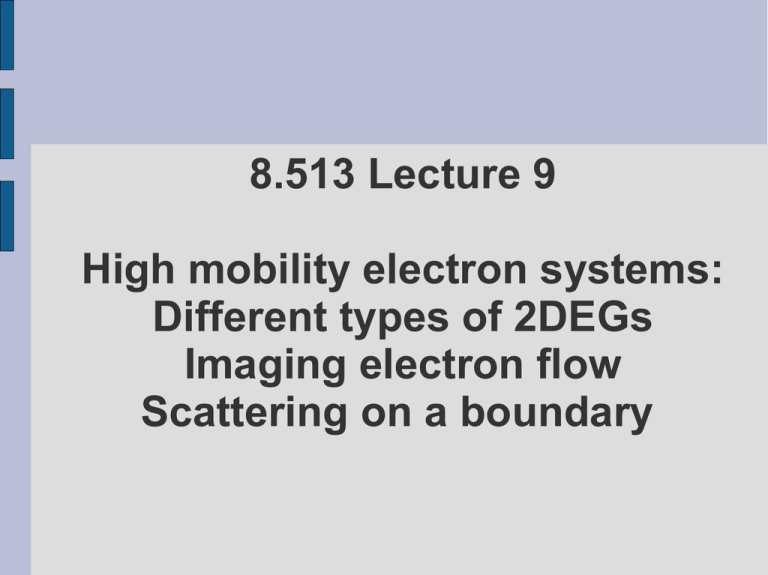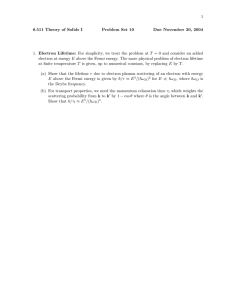Different types of 2DEGs Imaging electron flow Scattering on a
advertisement

8.513 Lecture 9 High mobility electron systems: Different types of 2DEGs Imaging electron flow Scattering on a boundary Two-dimensional electron systems ● ● ● ● ● Created on the interfaces in semiconductors by controled doping or field effect Quantum confinement in the perp direction: each discrete level gives a 2D band Tunable density of 2D carriers Effective mass, g-factor, SO interaction different from 2D bulk Valley splitting (e.g. in Si) Scattering mechanisms ● ● ● ● Coulomb scattering (charge impurities): distant (screened) and local residual impurities (weakly screened) Elastic: temperature independent; Surface roughness Inelastic: decerases at low T Intervalley scattering Lattice scattering: acoustic phonons, polar optical phonons, phonon-mediated intervalley scattering Mobility: j=env, v=E; Drude model: =(e/m)tr in best samples mobility can reach 14000000 cm^2/V s; mean free path of up to 120 m from: T. Heinzel “Mesoscopic Electronics...” Electron Electron Imaging electron flow through a QPC in a high mobility 2DEG Disorder potential and electron trajectory in a 2DEG: mostly small-angle scattering A two-dimensional electron gas formed at the interface between gallium arsenide and aluminum gallium arsenide in a semiconductor heterostructure. The AlGaAs layer (green) contains a layer (purple) of silicon donor atoms (dark blue). Electrons from the donor layer fall into the GaAs layer (pink) to form a 2DEG (blue) at the interface. The ionized Si donors (red) create a potential landscape for the electron gas; the resulting small-angle scattering smoothly bends electron trajectories, as shown. (from: Topinka, Westervelt, Heller, Physics Today December 2003) Response to a remote local probe Topinka et al, Nature 410, 183 (2001) a, Schematic diagram of the experimental set-up used for imaging electron flow. The tip introduces a movable depletion region which scatters electron waves flowing from the quantum point contact (QPC). An image of electron flow is obtained by measuring the effect the tip has on QPC conductance as a function of tip position. Two ohmic contacts approx1 mm away from the QPC (not shown) allow the conductance of the QPC to be measured using an a.c. lock-in amplifier at 11 kHz. The root-mean-square voltage across the QPC, 0.2 mV, was chosen in order not to heat electrons significantly above the lattice temperature of 1.7 K. b, Conductance of the QPC used for Fig. 2b versus QPC width controlled by the gate voltage. Steps at integer multiples of 2e2/h are clearly visible. The inset is a topographic AFM image of the QPC. Electron flow through a quantum point contact. (a) Scheme for imaging current flow through a QPC using scanning probe microscopy. Two gate electrodes (yellow) create a narrow constriction in the underlying two-dimensional electron gas. A charged tip (green) depletes the electron gas below it, creating a divot (red spot) that scatters incoming electron waves, as shown in the simulations (blue). (b) The conductance of the QPC, measured at 1.7 K, increases in quantized steps as the gate voltage (and QPC width) is increased. The insets below each step show simulations of the spatial pattern of electron flow for the transverse modes that contribute to the conductance. (c-e) Experimental images of electron flow at 1.7 K (left and right) and theoretical simulations (center) for the first three transverse modes of a QPC. The observed interference fringes spaced by half the Fermi wavelength demonstrate the coherence of electron flow. Because the additional flow, appearing as the QPC becomes wider, is due to the newly opened-up mode, the image for each transverse mode could be obtained by subtracting the raw images from the next lower step. Experimental images of electron flow. Image of electron flow from one side of a QPC at T = 1.7 K, biased on the G = 2e^2/h conductance step. Dark regions correspond to areas where the tip had little effect on QPC conductance, and hence are areas of low electron flow. The colour varies and the height in the scan increases with increasing electron flow. Narrow branching channels of electron flow are visible, and fringes spaced by lambdaF/2, half the Fermi wavelength, are seen to persist across the entire scan. b, Images of electron flow from both sides of a different QPC, again biased on the G = 2e2/h conductance step. The gated region in the centre was not scanned. Strong channelling and branching are again clearly visible. The white arrow points out one example of the formation of a cusp downstream from a dip in the potential. Calculated electron flow: branching strands, V-shaped cusps, focusing by ripples. Surface plot of the random potential for computed electron flow, including contributions from impurities, donors, and gates; green areas are low and white areas are high potential.The 'shadow' is cast by classical flux through the same potential. We note that the branched flux does not follow valleys in the potential. b, Classical and c, quantum-mechanical flux of electrons flowing through the potential in a. In the classical case, we followed the dynamics of an appropriate ensemble of classical trajectories and show the classical flux density. The quantum-mechanical results show the flux density of the transmitted wavefunction, coming through the point contact on the left. We note that both results show the same branching behaviour. QM model reproduces fringes spaced by F/2 Figure 4: Calculated tip scan. a, Quantum-mechanical flux through a random potential. b, The flux from the boxed area in a. c, A raster scan of conductance as a function of SPM tip position in the same system as a and b. The conductance image in the model corresponds to the flux image, confirming our assertion that the experiment images electron flow. Additionally, the simulation c shows quantum fringes, as seen in the experiment. Though this simulation is at zero temperature, the fringes do survive thermal averaging. Features ● ● ● ● Angular dependence of the flow agrees with the structure of uantized modes in a QPC Observe branched flow with V-shape cusps Consistent with earlier results on transport indicating dominant small-angle scattering Quantum coherence: fringes spaced by halfa-wavelength ? Boundary scattering ● ● ● ● Specular scattering (parallel momentum conserved): resistance unaffected, retains the bulk Drude value; Diffuse scattering (velocity fully randomized at each scattering on the boundary): resistance increased; In a narrow channel the channel width is effectively a mean free path for boundary scattering; A more general (heuristic) model: each electron reflected spectacularly with probability p and diffusely with probability 1-p Boltzmann equation In a channel with hard walls at x=+W/2,-W/2 and diffuse scattering, write stationary Boltzmann eqn The boundary condition at x=+W/2,-W/2: Find solution corresponding to constant density gradient along the channel: Classical size effect in resistivity General expression for resistivity in terms of the bulk value 0: A log-divergence! Electrons propagating nearly parallel to the channel travel over larg distances without collisions and effectively shortcircuit current The effect of magnetic field ● ● Trajectories bend in weak fields, enhancing scattering (“ballistic” carriers eliminated) In strong fields, backscattering suppressed, forward/backward trajectories at x=+W/2,-W/2 Magnetoresistance positive at low B, negative at high B


